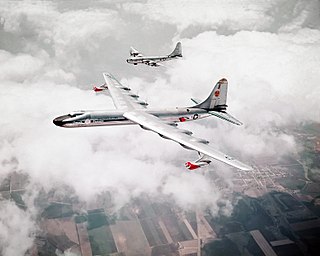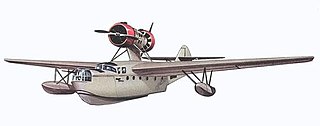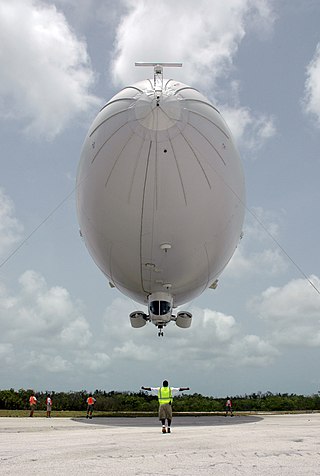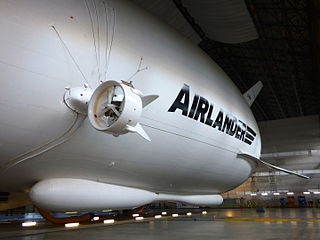
An airship or dirigible balloon is a type of aerostat or lighter-than-air aircraft that can navigate through the air under its own power. Aerostats gain their lift from a lifting gas that is less dense than the surrounding air.

The Zeppelin NT is a class of helium-filled airships being manufactured since the 1990s by the German company Zeppelin Luftschifftechnik GmbH (ZLT) in Friedrichshafen. The initial model is the N07. The company considers itself the successor of the companies founded by Ferdinand von Zeppelin which constructed and operated the very successful Zeppelin airships in the first third of the 20th century. There are, however, a number of notable differences between the Zeppelin NT and original Zeppelins as well as between the Zeppelin NT and usual non-rigid airships known as blimps. The Zeppelin NT is classified as a semi-rigid airship.

An aerostat is a lighter-than-air aircraft that gains its lift through the use of a buoyant gas. Aerostats include unpowered balloons and powered airships. A balloon may be free-flying or tethered. The average density of the craft is lower than the density of atmospheric air, because its main component is one or more gasbags, a lightweight skin containing a lifting gas to provide buoyancy, to which other components such as a gondola containing equipment or people are attached. Especially with airships, the gasbags are often protected by an outer envelope.
A circular wing is a disc-shaped wing having the outer planform of a circle.
The AEREON III was an experimental hybrid airship of rigid construction built by the AEREON Corporation in the early 1960s. Of unconventional design, the airship featured three gas envelopes attached side-by-side, with the connecting structures shaped as airfoils to create extra lift as the craft moved forward. Intended as a small prototype craft that would precede the development of much larger hybrid airships, the AEREON III was constructed between 1959 and 1965 but was destroyed during taxiing tests in 1966 and scrapped without having flown. It was "the first rigid airship to be built since Graf Zeppelin II".
The AEREON 26 was an experimental aircraft developed to investigate lifting body design with a view to using its shape to create hybrid designs, part airship, part conventional aircraft. It was powered by a piston engine, driving a pusher propeller, and generated lift through the aerodynamics of its lozenge-shaped fuselage.

A nuclear-powered aircraft is a concept for an aircraft intended to be powered by nuclear energy. The intention was to produce a jet engine that would heat compressed air with heat from fission, instead of heat from burning fuel. During the Cold War, the United States and Soviet Union researched nuclear-powered bomber aircraft, the greater endurance of which could enhance nuclear deterrence, but neither country created any such operational aircraft.

A hybrid airship or plimp is a powered aircraft that obtains some of its lift as a lighter-than-air (LTA) airship and some from aerodynamic lift as a heavier-than-air aerodyne.

The N-Class, or as popularly known, the "Nan ship", was a line of non-rigid airships built by the Goodyear Aircraft Company of Akron, Ohio for the US Navy. This line of airships was developed through many versions and assigned various designators as the airship designation system changed in the post World War II era. These versions included airships configured for both anti-submarine warfare and airborne early warning (AEW) missions.

Large aircraft allow the transportation of large and/or heavy payloads over long distances. Making an aircraft design larger can also improve the overall fuel efficiency and man-hours for transporting a given load, while a greater space is available for transporting lightweight cargoes or giving passengers room to move around. However, as aircraft increase in size they pose significant design issues not present in smaller types. These include structural efficiency, flight control response and sufficient power in a reliable and cost-effective installation.
The K-1 was an experimental blimp designed by the United States Navy in 1929. The K-1 was not the prototype of the later K-class blimps.

The Chyetverikov ARK-3 was a multi-role flying boat designed for Arctic operations that was built in the Soviet Union from 1933. It featured a conventional flying boat hull, with high cantilever wings equipped with floats at mid-span. The two piston engines were mounted in tractor-pusher fashion on a pylon above the fuselage.
Worldwide Aeros Corp is an American manufacturer of airships based in Montebello, California. It was founded in 1993 by the current CEO and Chief Engineer, Igor Pasternak, who was born in Soviet Kazakhstan, raised in Soviet Ukraine, and moved to the U.S. after the Soviet collapse to build airships there. It currently employs more than 100 workers.

SSclass airships were simple, cheap and easily assembled small non-rigid airships or "blimps" that were developed as a matter of some urgency to counter the German U-boat threat to British shipping during World War I. A secondary purpose was to detect and destroy mines. The class proved to be versatile and effective, with a total of 158 being built in several versions.

Airship Industries was a British manufacturers of modern non-rigid airships (blimps) active under that name from 1980 to 1990 and controlled for part of that time by Alan Bond. The first company, Aerospace Developments, was founded in 1970, and a successor, Hybrid Air Vehicles, remains active as of 2022. Airship Industries itself was active between 1980 and 1990.

The Hybrid Air Vehicles Airlander 10 is a hybrid airship designed and built by British manufacturer Hybrid Air Vehicles (HAV). Comprising a helium airship with auxiliary wing and tail surfaces, it flies using both aerostatic and aerodynamic lift and is powered by four diesel engine-driven ducted propellers.

The AeroLift CycloCrane was a unique US hybrid airship which adopted helicopter derived airfoil control for low speed flight manoeuvring by spinning on its axis. It was intended to be a heavy load lifter, initially aimed at the Canadian logging industry. A proof of concept vehicle flew at times during the 1980s, but no large production aircraft were built.
The CA 80 is a dirigible that was developed by the Conrad Airship Company.

The Skyship 500 is a non-rigid airship designed and built in the United Kingdom during the 1980s.

EKIP is the Soviet and Russian project of a multifunctional aerodrome-free aircraft, built according to the "flying wing" scheme, with an elliptically shaped fuselage. Also known by its Russian nickname of Tarielka, the EKIP can land on water or unpaved ground through the use of an air cushion instead of a wheeled undercarriage. The EKIP is a short takeoff and landing (STOL) aircraft.













